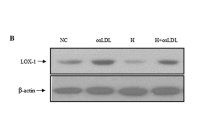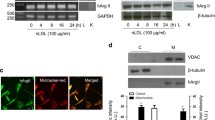Abstract
Objective
To test the hypothesis that the inhibition of endoplasmic reticulum (ER) stress-induced apoptosis in oxidized low-density lipoproteins (ox-LDL)-induced human aortic-vascular smooth muscle cells (HA-VSMCs) was associated with suppression of the protein kinase RNA-like ER kinase (PERK)-eukaryotic translation initiation factor 2α (eIF2α)-activating transcription factor 4 (ATF4)-CCAAT/enhancer binding protein homologous protein (CHOP) signaling pathway by Pollen Typhae total flavone (PTF).
Methods
Primary HA-VSMCs were cultured and identified. The cultured HA-VSMCs were randomized into 5 groups, including a normal control group, an ox-LDL group (70 μg/mL high ox-LDL), an HPTF group (70 μg/mL high ox-LDL+500 μg/mL PTF), an MPTF group (70 μg/mL high ox-LDL+250 μg/mL PTF), and a LPTF group (70 μg/mL high ox-LDL+100 μg/mL PTF) in the first part; and a normal control group, an ox-LDL group (70 μg/mL high ox-LDL), an MPTF group (70 μg/mL high ox-LDL+250 μg/mL PTF), a shRNA group (transducted with PERK shRNA lentiviral particles), a scramble shRNA group (transducted with control shRNA lentiviral particles), an MPTF+ox-LDL+shRNA group (250 μg/mL PTF+70 μg/mL high ox-LDL+PERK shRNA lentiviral particles) and an ox-LDL+shRNA group (70 μg/mL high ox-LDL+PERK shRNA lentiviral particles) in the second part. The protein expression levels of ER-associated apoptosis proteins were detected by Western blot, and their mRNA expression levels were detected by quantitative real-time reverse transcription-polymerase chain reaction. The 3-(4,5-dimethylthiazol-2-yl)-2,5-diphenyltetrazolium bromide (MTT) assay was applied to test cell viability, and the level of apoptosis was monitored by flow cytometry.
Results
The MTT assay and flow cytometry showed that the ox-LDL group had a significant increase in apoptosis, which was attenuated in PTF treatment groups and shRNA groups. Moreover, the ox-LDL group had increased protein and mRNA levels of binding immunoglobulin protein and ER-associated apoptosis proteins, such as PERK, eIF2α, ATF4 and CHOP, which were attenuated in PTF treatment groups and shRNA groups.
Conclusions
The apoptosis induced by ox-LDL had a strong relation to ER stress. The protective effect of PTF on ER stressinduced apoptosis was associated with inhibition of the PERK-eIF2α-ATF4-CHOP pathway, which might be a potential therapeutic strategy for enhancing the stability of atherosclerotic plaques.
Similar content being viewed by others
References
Libby P, Aikawa M. Stabilization of atherosclerotic plaques: new mechanisms and clinical targets. Nature Med 2002;8:1257–1262.
Muller JE, Tofler GH, Stone PH. Circadian variation and triggers of onset of acute cardiovascular disease. Circulation 1989;79:733–743.
Finn AV, Nakano M, Narula J, Kolodgie FD, Virmani R. Concept of vulnerable/unstable plaque. Arterioscler Thromb Vasc Biol 2010;30:1282–1292.
Burke AP, Farb A, Malcom GT, Liang YH, Smialek J, Virmani R. Coronary risk factors and plaque morphology in men with coronary disease who died suddenly. N Engl J Med 1997;336:1276–1282.
Libby P, Ridker PM, Hansson GK. Progress and challenges in translating the biology of atherosclerosis. Nature 2011;473:317–325.
Weber C, Noels H. Atherosclerosis: current pathogenesis and therapeutic options. Nature Med 2011;17:1410–1422.
Gorenne I, Kumar S, Gray K, Figg N, Yu H, Mercer J, et al. Vascular smooth muscle cell sirtuin 1 protects against DNA damage and inhibits atherosclerosis. Circulation 2013;127:386–396.
Clarke MC, Figg N, Maguire JJ, Davenport AP, Goddard M, Littlewood TD, et al. Apoptosis of vascular smooth muscle cells induces features of plaque vulnerability in atherosclerosis. Nature Med 2006;12:1075–1080.
Bauriedel G, Hutter R, Welsch U, Bach R, Sievert H, Lüderitz B. Role of smooth muscle cell death in advanced coronary primary lesions: implications for plaque instability. Cardiovasc Res 1999;41:480–488.
Clarke MC, Littlewood TD, Figg N, Maguire JJ, Davenport AP, Goddard M, et al. Chronic apoptosis of vascular smooth muscle cells accelerates atherosclerosis and promotes calcification and medial degeneration. Circ Res 2008;102:1529–1538.
Larroque-Cardoso P, Swiader A, Ingueneau C, Nègre-Salvayre A, Elbaz M, Reyland ME, et al. Role of protein kinase C d in ER stress and apoptosis induced by oxidized LDL in human vascular smooth muscle cells. Cell Death Dis 2013;4:e520.
Wang JC, Bennett M. Aging and atherosclerosis: mechanisms, functional consequences, and potential therapeutics for cellular senescence. Circ Res 2012;111:245–259.
Steinberg D, Parthasarathy S, Carew TE, Khoo JC, Witztum JL. Beyond cholesterol. Modifications of lowdensity lipoprotein that increase its atherogenicity. N Engl J Med 1989;320:915–924.
Tabas I. The role of endoplasmic reticulum stress in the progression of atherosclerosis. Circ Res 2010;107:839–850.
Minamino T, Komuro I, Kitakaze M. Endoplasmic reticulum stress as a therapeutic target in cardiovascular disease. Circ Res 2010;107:1071–1082.
Zinszner H, Kuroda M, Wang X, Batchvarova N, Lightfoot RT, Remotti H, et al. CHOP is implicated in programmed cell death in response to impaired function of the endoplasmic reticulum. Genes Dev 1998;12:982–995.
Mccullough KD, Martindale JL, Klotz LO, Aw TY, Holbrook NJ. Gadd153 sensitizes cells to endoplasmic reticulum stress by down-regulating Bcl2 and perturbing the cellular redox state. Mol Cell Biol 2001;21:1249–1259.
Myoishi M, Hao H, Kitakaze M. Increased endoplasmic reticulum stress in atherosclerotic plaques associated with acute coronary syndromes. Circulation 2007;116:1214–1216.
Zhou AX, Tabas I. The UPR in atherosclerosis. Semin Immunopathol 2013;35:321–332.
Jiang LK, Huang WQ. Effects of Pollen Typhae on the rat models of atherosclerosis by hyperlipidemia. J Emerg Tradit Chin Med (Chin) 2009;11:108–113.
Zhao J, Zhang CY, Xu DM, Huang GQ. The antiatherogenic effects of components isolated from Pollen Typhae. Thromb Res 1990;57:957–966.
Fu XD, He YM, Chen WH, Ying J, Wang WJ. Pollen Typhae total flavone enhances proliferation and differentiation of 3T3-L1 adipocytes and up-regulates related gene expressions. J Med Postgrad (Chin) 2010;31:103–106.
Zhang J, Zhou Z, Zuo B. Protective effects of Pollen Typhae on vascular endothelial dysfunction induced by hyperlipemia in rabbits. Pharm Clin Chin Mater Med (Chin) 2003;42:125–131.
Zulli A, Lau E, Wijaya BP, Jin X, Sutarga K, Schwartz GD, et al. High dietary taurine reduces apoptosis and atherosclerosis in the left main coronary artery: association with reduced CCAAT/enhancer binding protein homologous protein and total plasma homocysteine but not lipidemia. Hypertension 2009;53:1017–1022.
Ding Z, Wang X, Schnackenberg L, Khaidakov M, Liu S, Singla S, et al. Regulation of autophagy and apoptosis in response to ox-LDL in vascular smooth muscle cells, and the modulatory effects of the microRNA hsa-let-7g. Int J Cardiol 2013;168:1378–1385.
Xu K, Yan M, Wang Y, Yang Y, Zheng, X. Free cholesterol overloading induced smooth muscle cells death and activated both ER- and mitochondrial-dependent death pathway. Atherosclerosis 2009;207:123–130.
Kim H. The presence of malfolded proteins in the endoplasmic reticulum signals the induction of glucoseregulated proteins. Nature 1988;332:462–464.
Sitia R, Braakman I. Quality control in the endoplasmic reticulum protein factory. Nature 2003;426:891–894.
Cunard R, Sharma K. The endoplasmic reticulum stress response and diabetic kidney disease. Am J Physiol Renal Physiol 2011;300:1054–1061.
Bertolotti A, Zhang Y, Hendershot LM, Harding HP, Ron D. Dynamic interaction of BiP and ER stress transducers in the unfolded-protein response. Nature Cell Biol 2000;2:326–332.
Walter P, Ron D. The unfolded protein response: from stress pathway to homeostatic regulation. Science 2011;334:1081–1086.
Harding HP, Novoa I, Zhang Y, Zeng H, Wek R, Schapira M, et al. Regulated translation initiation controls stress-induced gene expression in mammalian cells. Mol Cell 2000;6:1099–1108.
Author information
Authors and Affiliations
Corresponding author
Additional information
Supported by the National Natural Science Foundation of China (No. 81573922), the Traditional Chinese Medicine Scientific Research Project of Guangdong Province, China (No. 20151076), and the Sanming Project of Medicine in Shenzhen, China (No. SZSM201612033)
Electronic supplementary material
Rights and permissions
About this article
Cite this article
Chen, Mt., Huang, Rl., Ou, Lj. et al. Pollen Typhae Total Flavone Inhibits Endoplasmic Reticulum Stress-Induced Apoptosis in Human Aortic-Vascular Smooth Muscle Cells through Down-Regulating PERK-eIF2α-ATF4-CHOP Pathway. Chin. J. Integr. Med. 25, 604–612 (2019). https://doi.org/10.1007/s11655-019-3052-4
Received:
Published:
Issue Date:
DOI: https://doi.org/10.1007/s11655-019-3052-4




